Prediction of Structural Fracture Distribution and Analysis of Controlling Factors in a Passive Continental Margin Basin—An Example of a Clastic Reservoir in Basin A, South America
Abstract
:1. Introduction
2. Materials and Methods
2.1. Regional Geological Setting
2.2. Structural Fracture Characteristics
2.3. Method for Numerical Simulation of Tectonic Stress Field
2.3.1. Geological Model
2.3.2. Mechanical Model
2.3.3. Mathematical Model
2.3.4. Boundary Conditions
2.4. Method for Structural Fracture Prediction
2.4.1. Griffith Criterion
2.4.2. Calculation of Rupture Factor
3. Results
3.1. Results of Stress Modelling
3.2. Results of Fracture Prediction
4. Discussion
4.1. Evaluation of Fracture Prediction Results
4.2. Controlling Factors for Structural Fractures
4.2.1. Relationship between Fracture Zone and Fracture
4.2.2. Relationship between Sedimentary Facies and Fracture
5. Conclusions
Author Contributions
Funding
Institutional Review Board Statement
Informed Consent Statement
Data Availability Statement
Conflicts of Interest
References
- Jia, H. Global Progress in the Exploration of Major Oil and Gas Fields and Exploration Insights. Sci. Technol. Rev. 2014, 32, 76–83. [Google Scholar] [CrossRef]
- The top ten discoveries of oil and gas in the world in 2019. China Geol. 2020, 47, 261.
- Wang, D.; Kong, X.; Tian, K.; Guo, J.; Yin, J. Global major oil and gas discoveries in 2023 and exploration outlook in 2024. World Pet. Ind. 2024, 31, 1–10. [Google Scholar] [CrossRef]
- Deng, Y.; Sun, T. On the Symbiotic Relationship Between High-Quality Source Rocks and Large Oil Fields. China Offshore Oil Gas 2019, 31, 1–8. [Google Scholar]
- Deng, Y.; Jia, H.; Liu, Q. Formation Mechanism and Exploration Practice of Oil and Gas Reservoirs in Deepwater Areas of Atlantic Passive Marginal Basins. China Offshore Oil Gas 2021, 33, 1–10. [Google Scholar] [CrossRef]
- Wang, K.; Zhang, H.; Zhang, R.; Dai, J.; Wang, J.; Zhao, L. Comprehensive Evaluation of Reservoir Structural Fractures in the Keshen 2 Gas Field, Tarim Basin. Using Mult. Methods. Acta Pet. Sin. 2015, 36, 673–687. [Google Scholar] [CrossRef]
- Ding, Z.; Qian, X.; Huo, H.; Yang, Y. A New Method for Quantitative Prediction of Structural Fractures: The Binary Method. Oil Gas Geol. 1998, 19, 14. [Google Scholar]
- Ju, W.; Hou, G.; Feng, S.; Zhao, W.; Zhang, J.; You, Y.; Zhan, Y.; Yu, X. Quantitative Prediction of Structural Fractures in the Chang 63 Reservoir of the Qingcheng-Heshui Area. Ordos Basin. Geosci. Front. 2014, 21, 310–320. [Google Scholar] [CrossRef]
- Tong, H. Research Progress in Reservoir Fracture Description and Prediction. J. Pet. Educ. Inst. Xinjiang 2004, 16, 9–13. [Google Scholar]
- Wu, G.; Li, J.; Yang, S.; Gao, H.; Peng, S.; Cao, S. Fractal Characteristics of Ordovician Carbonate Rock Fractures and Faults in the Central Tarim Basin. Chin. J. Geol. 2002, 37, 51–56. [Google Scholar]
- Yin, X.; Ma, N.; Ma, Z.; Zong, Z. Research Status and Progress of Earth Stress Prediction Technology. Geophys. Prospect. Pet. 2018, 57, 488–504. [Google Scholar] [CrossRef]
- Dong, C.; Sun, Y.; Ma, C.; Ren, L.; Liang, S.; Zhang, Z. Research on Logging Identification Method of Natural Fractures Based on Geological Pattern Constraints. Prog. Geophys. 2020, 35, 1352–1363. [Google Scholar] [CrossRef]
- Hu, W. Application of Coherence Cube Technology in Northeast Sichuan Oil and Gas Exploration. Comput. Tech. Geophys. Geochem. Explor. 2010, 32, 5. [Google Scholar]
- Liu, X.; Sun, Q.; Liu, J.; Liu, W. Predicting fracture porosity in carbonate reservoirs using seismic attributes, multivariate statistical analysis theory and ANFIS. Well Logging Technol. 2009, 33, 257–260. [Google Scholar] [CrossRef]
- Gu, W.; Wang, D.H.; Yan, J. Seismic multi-attribute based crack detection. Nat. Gas Explor. Dev. 2013, 36, 6. [Google Scholar]
- Xu, K. Fracture prediction and analysis of main controlling factors in tight carbonate gas reservoirs—A case study of the reservoirs of the Lampshade Formation in the Gaoshitian area of the Sichuan Basin. J. Min. Sci. Technol. 2024, 9, 327–341. [Google Scholar] [CrossRef]
- Dai, J.S.; Shang, L.; Wang, T.D.; Jia, K.F. Numerical simulation of the present-day ground stress field and prediction of effective fracture distribution in Fengshan Formation, Futai Subterranean Mountains. Pet. Geol. Recovery Effic. 2014, 21, 4. [Google Scholar] [CrossRef]
- Liu, C.; Wang, X.; Zhao, C.; Yin, S. Paleotectonic stress field simulation and fracture prediction in dense sandstones of the Shanxi Formation in the southern part of the Qingshui Basin. Geophys. Prospect. Pet. 2019, 58, 292–302+312. [Google Scholar] [CrossRef]
- Xu, K.; Dai, J.S.; Feng, J.W.; Ren, Q.Q. Control of fracture distribution by faults in the Mianxi-Gaoshitian block. J. Southwest Pet. Univ. 2019, 41, 10–22. [Google Scholar]
- Ren, Q.Q.; Jin, Q.; Feng, Z.D.; Feng, J.W.; Du, H.; Zhang, Y.J. Prediction of tectonic fracturing during the critical period of Ordovician carbonate reservoirs in the Hetianhe gas field. J. China Univ. Pet. 2020, 44, 1–13. [Google Scholar] [CrossRef]
- Tan, Z.; Deng, J.; Zhang, Q.; Guo, M.; Li, H.; Du, H.; Feng, J. Quantitative Characterization of Volcanic Thermal Expansion-Type Cracks Based on Thermal Coupling Analysis. Earth Sci. 2023, 48, 2665–2677. [Google Scholar]
- Bao, D.; Cao, F.; Zhang, J.; Wang, S.; Yu, C.; Lu, Z. Simulation of stress field in ultra deep strike slip fault zone and its development significance: A case study of the southern section of Shunbei No. 5 fault zone. Sci. Technol. Eng. 2023, 23, 13254–13264. [Google Scholar]
- Ma, J.; He, D.; Zhang, W.; Lu, G.; Zhang, X.; Mei, Q. Numerical simulation of present-day stress field on the top surface of Ordovician Wufeng Formation shale in the Shilongxia anticline area, Southeast Sichuan, China. Chin. J. Geol. 2024, 59, 792–803. [Google Scholar] [CrossRef]
- Zhang, D.; Chen, K.; Tang, J.; Tuo, X.; Ma, S. Paleotectonic Stress Field and Fracture Prediction of Silurian Longmaxi Formation in Jingmen Area, Western Hubei. Acta Geosci. Sin. 2024, 45, 217–231. [Google Scholar] [CrossRef]
- Bao, H.; Liu, C.; Gan, Y. Paleotectonic stress field and fracture characteristics of shales of Ordovician Wufeng Formation to Silurian Longmaxi Formation in southern Fuling area, Sichuan Basin. Lithol. Reserv. 2024, 36, 14–22. [Google Scholar] [CrossRef]
- Pang, Y.; Chen, K.; Zhang, P.; He, G.; Tang, J.; Zhang, D.; Gao, L.; Yan, C.; Wang, Y. Simulation of paleo tectonic stress field of Silurian Longmaxi Formation in Wulong area of southeastern Chongqing. Acta Seismol. Sin. 2024, 46, 1–19. [Google Scholar] [CrossRef]
- Feng, J.; Qu, J.; Wan, H.; Ren, Q. Quantitative Prediction of Multiperiod Fracture Distributions in the Cambrian-Ordovician Buried Hill within the Futai Oilfield, Jiyang Depression, East China. J. Struct. Geol. 2021, 148, 104359. [Google Scholar] [CrossRef]
- Zhuo, Q.; Zhang, F.; Zhang, B.; Radwan, A.E.; Yin, S.; Wu, H.; Wei, C.; Gou, Y.; Sun, Y. Tectonic Fracture Prediction for Lacustrine Carbonate Oil Reservoirs in Paleogene Formations of the Western Yingxiongling Area, Qaidam Basin, NW China Based on Numerical Simulation. Carbonates Evaporites 2024, 39, 38. [Google Scholar] [CrossRef]
- Li, J.; Zu, K.; Li, Q.; Zeng, D.; Li, Z.; Zhang, J.; Luo, Z.; Yin, N.; Zhu, Z.; Ding, X. Prediction of Fracture Opening Pressure in a Reservoir Based on Finite Element Numerical Simulation: A Case Study of the Second Member of the Lower Triassic Jialingjiang Formation in Puguang Area, Sichuan Basin, China. Front. Earth Sci. 2022, 10, 839084. [Google Scholar] [CrossRef]
- Yang, W.; Escalona, A. Tectonostratigraphic Evolution of the Guyana Basin. AAPG Bull. 2011, 95, 1339–1368. [Google Scholar] [CrossRef]
- Hermeston, S.; Torres, M.; Kean, A.; Ramos, D.; Brisson, I. E020 New Exploration in the Proven Petroleum System of the Suriname Offshore Basin, Suriname. In Proceedings of the 67th EAGE Conference & Exhibition, Madrid, Spain, 13–16 June 2005; European Association of Geoscientists & Engineers: Madrid, Spain, 2005. [Google Scholar]
- Torres, M.A.; Giraudo, R.; Hermeston, S.; Ramos, D. Exploration Potential of the Berbice Mega Incised Valley, Guyana-Suriname Basin. In Proceedings of the 67th EAGE Conference & Exhibition, Madrid, Spain, 13–16 June 2005; European Association of Geoscientists & Engineers: Madrid, Spain, 2005. [Google Scholar]
- Ju, W.; Wang, J.; Fang, H.; Sun, W. Paleotectonic Stress Field Modeling and Prediction of Natural Fractures in the Lower Silurian Longmaxi Shale Reservoirs, Nanchuan Region, South China. Mar. Pet. Geol. 2019, 100, 20–30. [Google Scholar] [CrossRef]
- Ma, C.; Sun, W.; Zeng, L.; Han, H.; Zhan, Y.; Du, G.; Shi, Z. Tectonic fracture size analysis based on core fracture observation in shale of Kong II section of Cangdong Depression. J. China Univ. Pet. 2023, 47, 1–11. [Google Scholar] [CrossRef]
- Odling, N.E.; Gillespie, P.; Bourgine, B.; Castaing, C.; Chiles, J.-P.; Christensen, N.P.; Fillion, E.; Genter, A.; Olsen, C.; Thrane, L.; et al. Variations in Fracture System Geometry and Their Implications for FLuid FLow in Fractured Hydrocarbon Reservoirs. Pet. Geosci. 1999, 5, 373–384. [Google Scholar] [CrossRef]
- Fossen, H. Structural Geology; Cambridge University Press: Cambridge, UK, 2010; p. 463. [Google Scholar]
- Ge, H.; Lin, Y.-S.; Wang, S.-C. Geostress testing and its application in exploration and development. J. China Univ. Pet. 1998, 97–102, 119–120. [Google Scholar]
- Huang, B. Research on the Method of Analyzing Geostress in Imaging Logging. Master’s Thesis, China University of Geosciences Beijing, Beijing, China, 2008. [Google Scholar]
- Wang, Q.; Hu, X.; Zhu, R. A review of tectonic stress field studies. J. Yunnan Univ. 2014, 36, 122–129. [Google Scholar]
- Ding, W.L.; Zeng, W.T.; Wang, Y.Y.; Jiukai, J.K.; Wang, Z.; Sun, Y.X.; Wang, X.H. Tectonic Stress Field Simulation and Fracture Distribution Prediction of Shale Reservoirs: Methods and Applications. Geosci. Front. 2016, 23, 63–74. [Google Scholar] [CrossRef]
- Li, X.; Wu, L.; Wang, B.; Hu, Q.; Dong, D. Numerical Simulation of Structural Stress Field in the Longmaxi Formation of Southeast Chongqing and Prediction of Favorable Fracture Areas. Bull. Geol. Sci. Technol. 2021, 40, 24–31. [Google Scholar] [CrossRef]
- Xie, J.; Fu, X.; Qin, Q.; Fan, C.; Ni, K.; Huang, M. Prediction of fracture distribution in shale reservoirs and evaluation of shale gas preservation conditions in Dingshan area. Spec. Oil Gas Reserv. 2022, 29, 1–9. [Google Scholar] [CrossRef]
- Jin, Y.; Chen, M.; Zhou, J.; Geng, Y. An experimental study on the effect of lithologic mutants on hydraulic fracture extension. Acta Pet. Sin. 2008, 29, 300–303. [Google Scholar]
- Fischer, K.; Henk, A. 3-D Geomechanical Modelling of a Gas Reservoir in the North German Basin: Workflow for Model Building and Calibration. Solid Earth Discuss. 2013, 5, 767–788. [Google Scholar] [CrossRef]
- Ju, W.; Sun, W. Tectonic Fractures in the Lower Cretaceous Xiagou Formation of Qingxi Oilfield, Jiuxi Basin, NW China. Part Two: Numerical Simulation of Tectonic Stress Field and Prediction of Tectonic Fractures. J. Pet. Sci. Eng. 2016, 146, 626–636. [Google Scholar] [CrossRef]
- Li, G.; Ma, H.; Qian, J.Z.; Zhang, Q. Experimentation and simulation of rock fracture containing different numbers of cracks. Ind. Constr. 2021, 51, 181–187. [Google Scholar] [CrossRef]
- Wu, Z. A Study on the Fracture Characteristics and Distribution Prediction of Shale Reservoirs in the Lower Cambrian Niushutang Formation—A Case Study of Fenggang Block III, Guizhou. Ph.D. Thesis, Guizhou University, Guiyang, China, 2018. [Google Scholar]
- Zhou, J.X. Equilibrium profiling method for tectonic evolution recovery in syn-sedimentary squeeze basins and its application. Acta Geosci. Sin. 2005, 26, 151–156. [Google Scholar]
- Zhao, J. Characteristics of Cenozoic Tectonic Deformation and Its Geotectonic Significance in the Jiangzi-Qusong Region, South Tibet. Master’s Thesis, China University of Geosciences Beijing, Beijing, China, 2022. [Google Scholar]
- Dahlstrom, C.D.A. Balanced Cross Sections. Can. J. Earth Sci. 1969, 6, 743–757. [Google Scholar] [CrossRef]
- Liang, H. Mechanism of Brittle Rock Fracture in Shale Reservoir and Evaluation Method. Master’s Thesis, Southwest Petroleum University, Chengdu, China, 2015. [Google Scholar]
- Wu, Z.; Zuo, Y.; Wang, S.; Chen, J.; Wang, A.; Liu, L.; Xu, Y.; Sunwen, J.; Cao, J.; Yu, M.; et al. Numerical Study of Multi-Period Palaeotectonic Stress Fields in Lower Cambrian Shale Reservoirs and the Prediction of Fractures Distribution: A Case Study of the Niutitang Formation in Feng’gang No. 3 Block, South China. Mar. Pet. Geol. 2017, 80, 369–381. [Google Scholar] [CrossRef]
- Ju, W.; Sun, W. Tectonic Fractures in the Lower Cretaceous Xiagou Formation of Qingxi Oilfield, Jiuxi Basin, NW China Part One: Characteristics and Controlling Factors. J. Pet. Sci. Eng. 2016, 146, 617–625. [Google Scholar] [CrossRef]
- Nelson, R.A. 5-Analysis Procedures in Fractured Reservoirs. In Geologic Analysis of Naturally Fractured Reservoirs, 2nd ed.; Nelson, R.A., Ed.; Gulf Professional Publishing: Woburn, MA, USA, 2001; pp. 223–253. ISBN 978-0-88415-317-7. [Google Scholar]
- Lorenz, J.C.; Sterling, J.L.; Schechter, D.S.; Whigham, C.L.; Jensen, J.L. Natural Fractures in the Spraberry Formation, Midland Basin, Texas: The Effects of Mechanical Stratigraphy on Fracture Variability and Reservoir Behavior. Bulletin 2002, 86, 505–524. [Google Scholar] [CrossRef]
- Liu, J.; Ding, W.; Yang, H.; Jiu, K.; Wang, Z.; Li, A. Quantitative Prediction of Fractures Using the Finite Element Method: A Case Study of the Lower Silurian Longmaxi Formation in Northern Guizhou, South China. J. Asian Earth Sci. 2018, 154, 397–418. [Google Scholar] [CrossRef]
- Yang, G. Analysis of formation mechanism and control factors of Triassic sandstone fracture. Fault Block Oillgas Field 2009, 16, 22–24. [Google Scholar]
- Zhang, Z.; Zhang, S.; He, X.; Xie, D.; Liu, Y. Development characteristics of fractures in the second member of Xujiahe Formation in Hexingchang Gas Field, western Sichuan Depression and their main control factors of formation: A case study of Hexingchang Gas Field. Pet. Reserv. Eval. Dev. 2023, 13, 581–590. [Google Scholar] [CrossRef]
- Gong, L.; Gao, M.; Zeng, L.; Fu, X.; Gao, Z.; Gao, A.; Zu, K.; Yao, J. Controlling factors on fracture development in the tight sandstone reservoirs:A case study of Jurassic Neogene in the kuqa foreland basin. Nat. Gas Geosci. 2017, 28, 199–208. [Google Scholar]
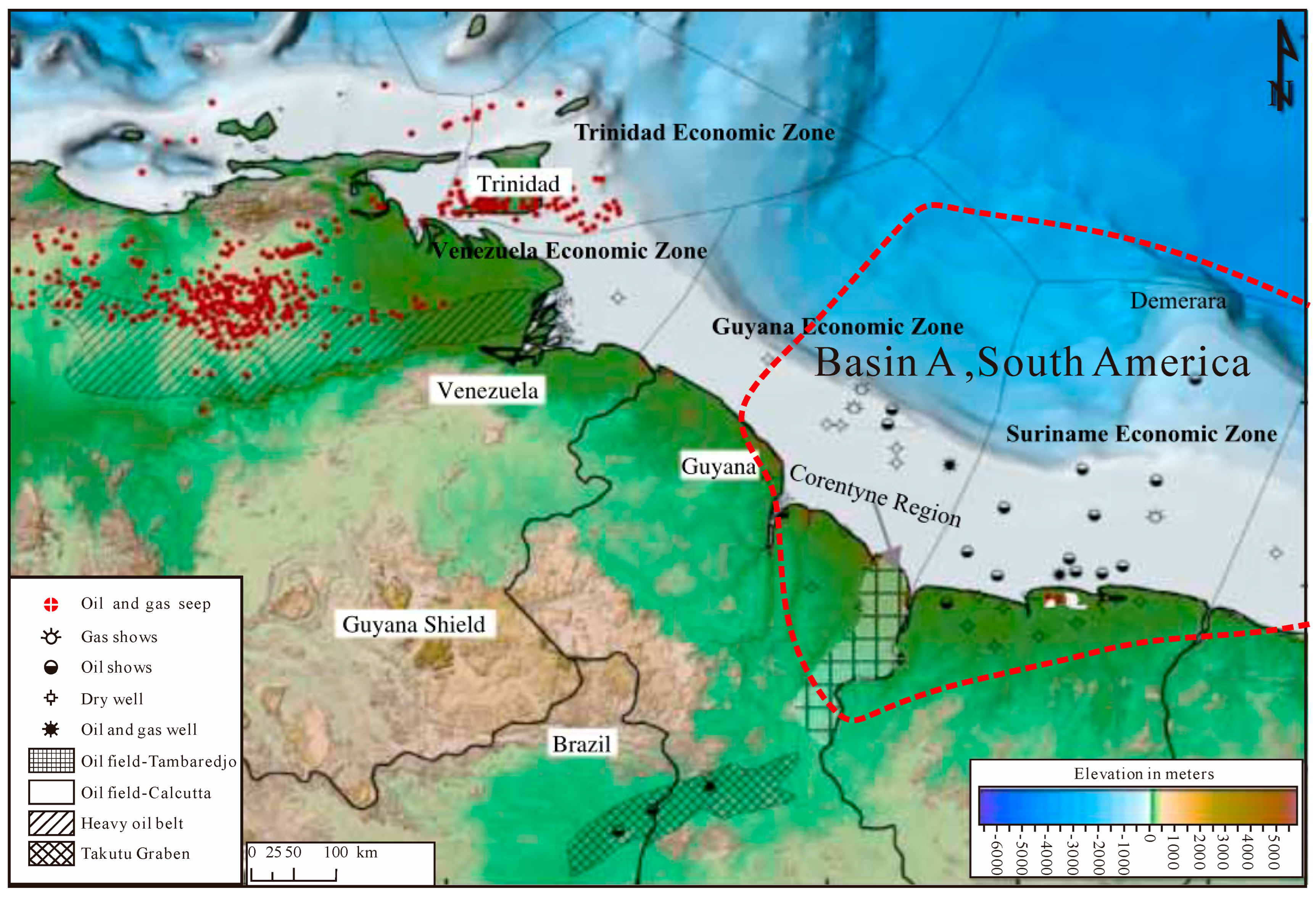
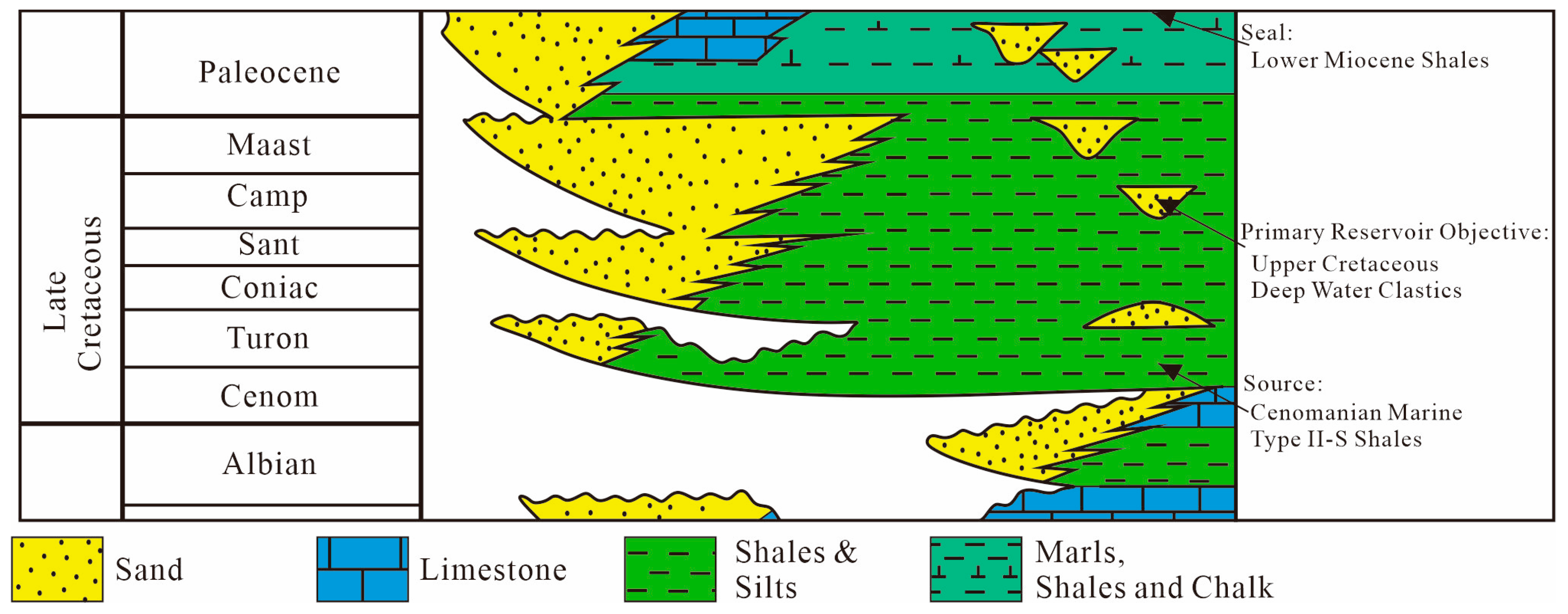

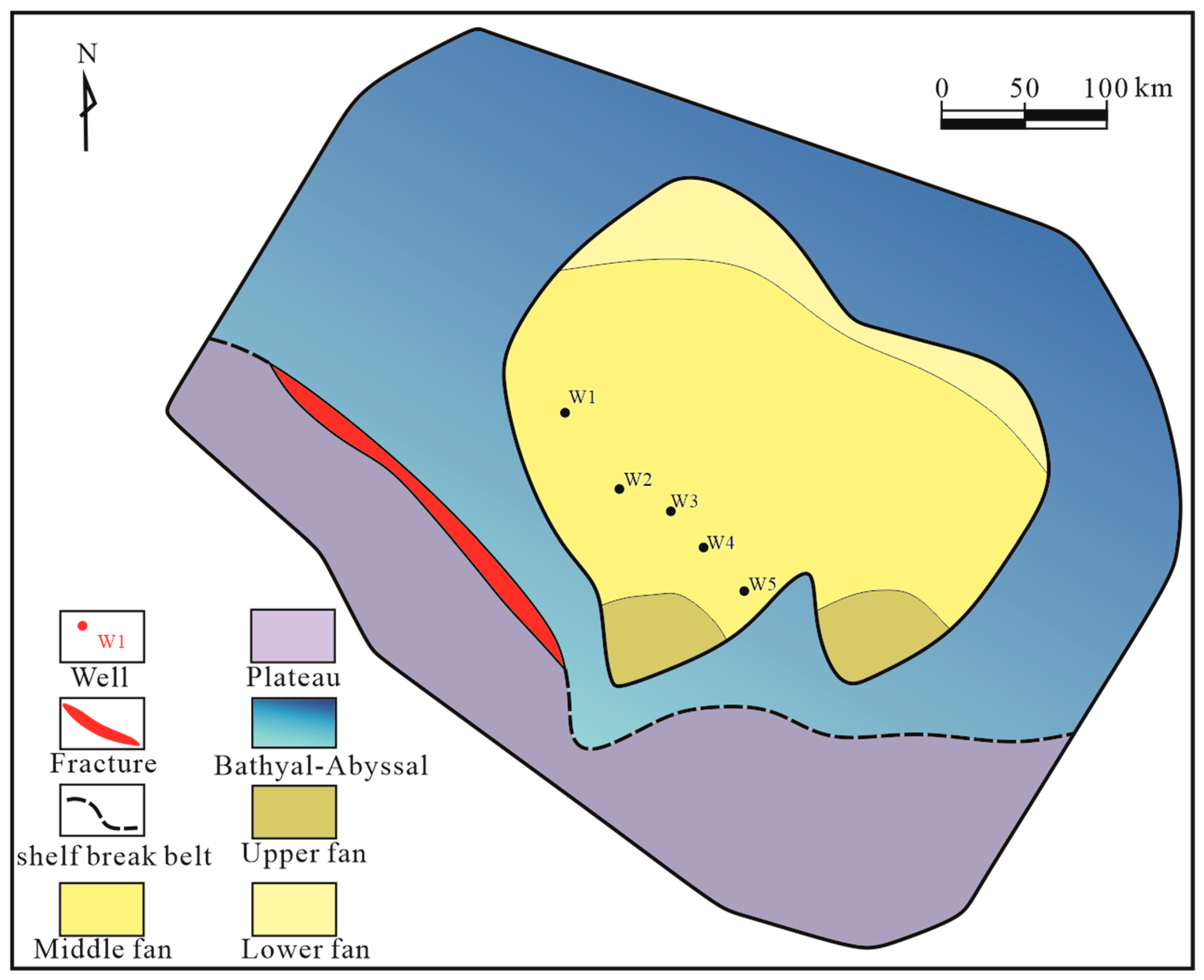

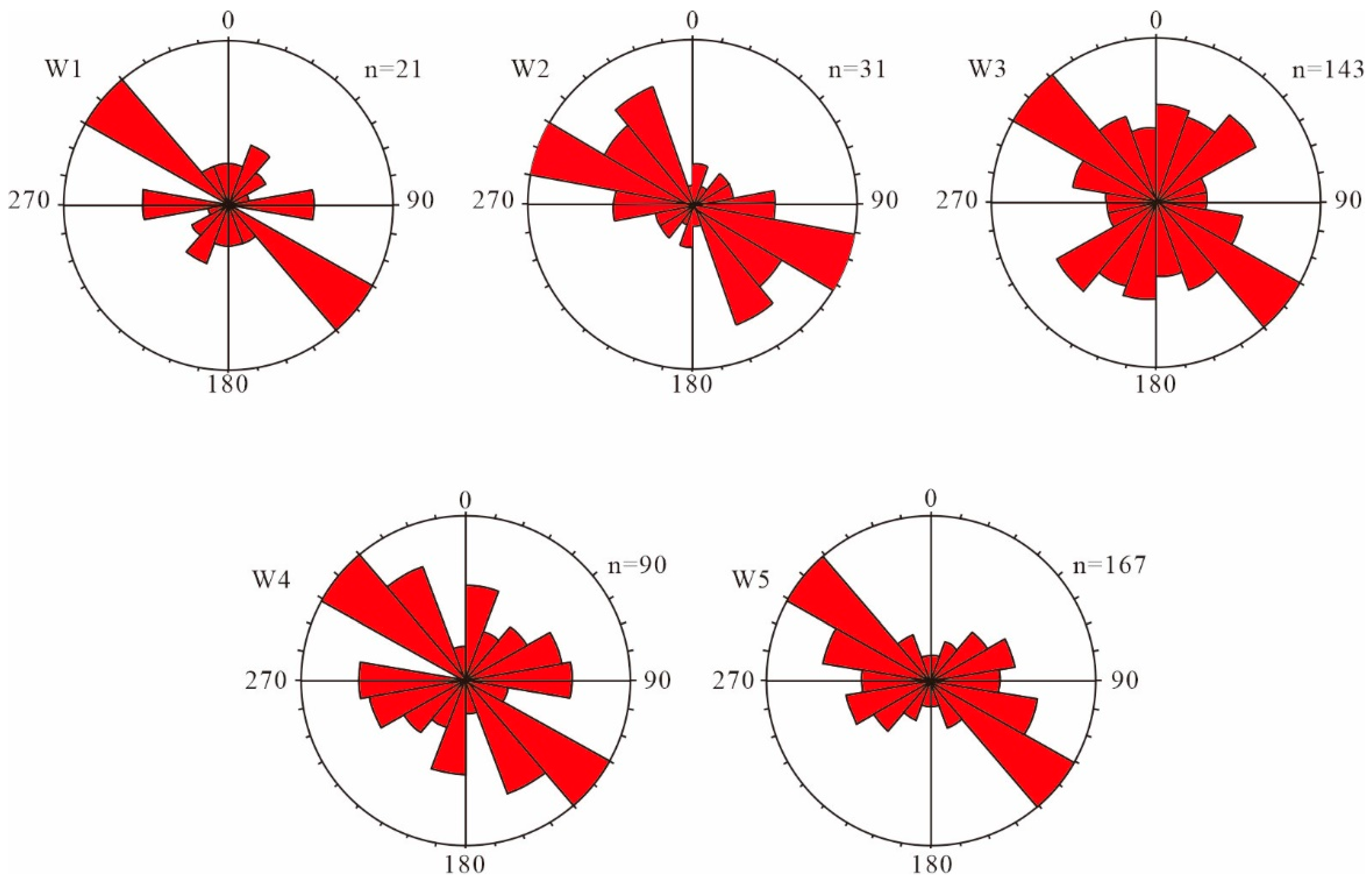
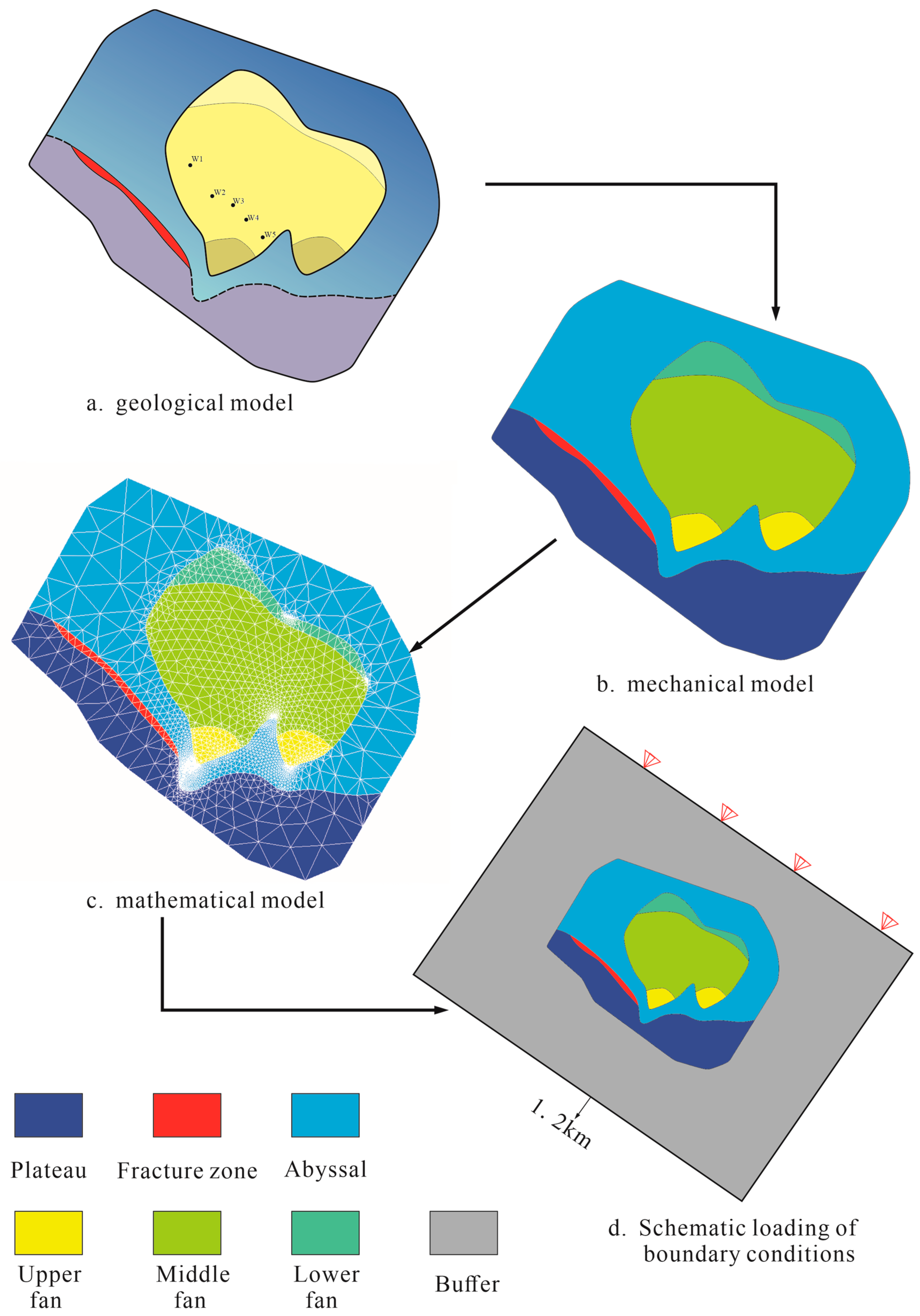

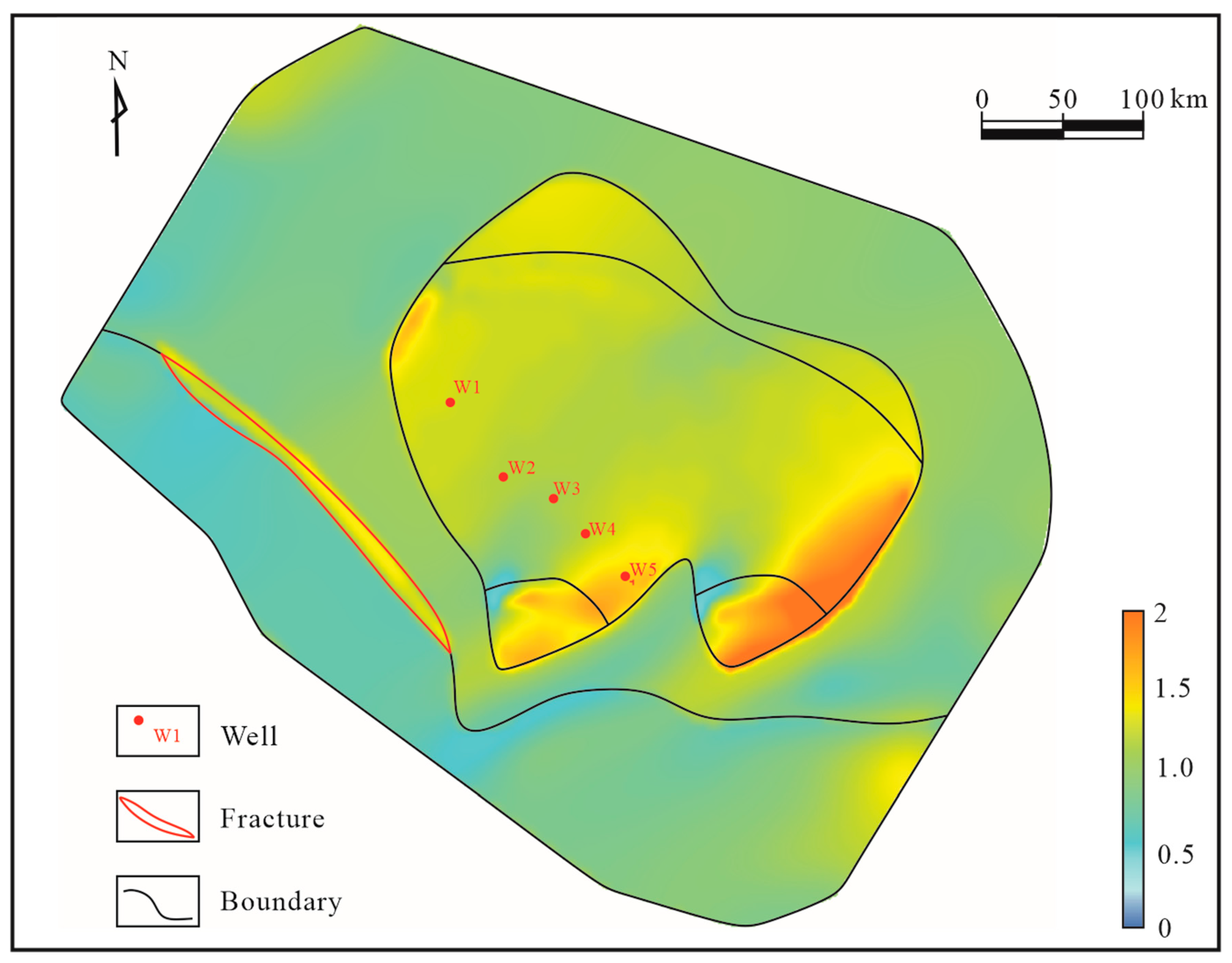
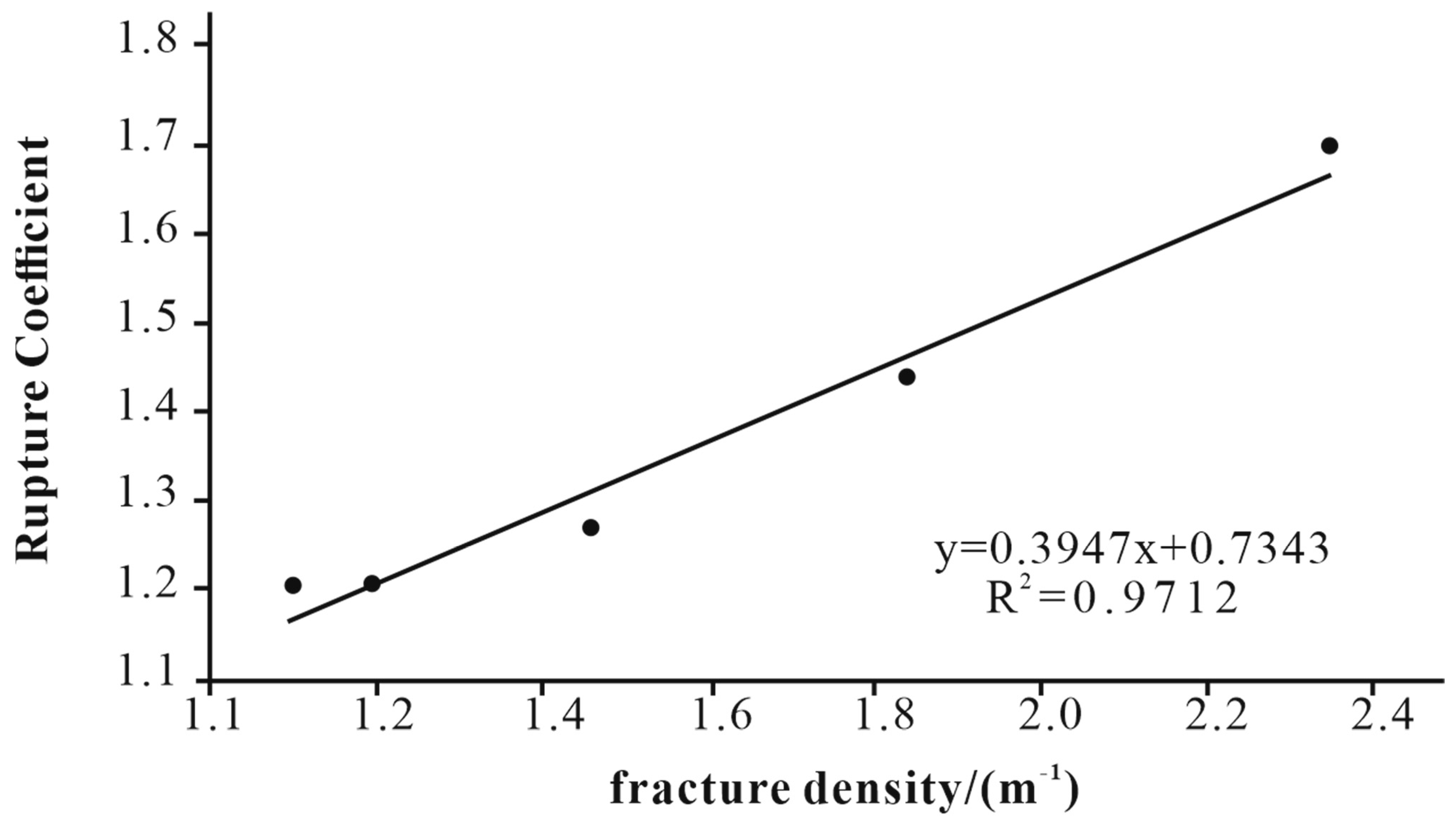


| Rock Mechanics Parameters | Mechanical Unit | ||||
|---|---|---|---|---|---|
| Abyssal | Upper Fan | Middle Fan | Lower Fan | Plateau | |
| Young’s modulus of elasticity/Gpa | 16.80 | 17.17 | 19.62 | 24.75 | 27.50 |
| Poisson’s ratio | 0.317 | 0.296 | 0.312 | 0.262 | 0.248 |
| tensile strength/Mpa | 11.25 | 11.09 | 12.08 | 12.65 | 13.00 |
Disclaimer/Publisher’s Note: The statements, opinions and data contained in all publications are solely those of the individual author(s) and contributor(s) and not of MDPI and/or the editor(s). MDPI and/or the editor(s) disclaim responsibility for any injury to people or property resulting from any ideas, methods, instructions or products referred to in the content. |
© 2024 by the authors. Licensee MDPI, Basel, Switzerland. This article is an open access article distributed under the terms and conditions of the Creative Commons Attribution (CC BY) license (https://creativecommons.org/licenses/by/4.0/).
Share and Cite
Guo, R.; Shi, J.; Jiang, S.; Jiang, S.; Cai, J. Prediction of Structural Fracture Distribution and Analysis of Controlling Factors in a Passive Continental Margin Basin—An Example of a Clastic Reservoir in Basin A, South America. Appl. Sci. 2024, 14, 7271. https://doi.org/10.3390/app14167271
Guo R, Shi J, Jiang S, Jiang S, Cai J. Prediction of Structural Fracture Distribution and Analysis of Controlling Factors in a Passive Continental Margin Basin—An Example of a Clastic Reservoir in Basin A, South America. Applied Sciences. 2024; 14(16):7271. https://doi.org/10.3390/app14167271
Chicago/Turabian StyleGuo, Rong, Jinxiong Shi, Shuyu Jiang, Shan Jiang, and Jun Cai. 2024. "Prediction of Structural Fracture Distribution and Analysis of Controlling Factors in a Passive Continental Margin Basin—An Example of a Clastic Reservoir in Basin A, South America" Applied Sciences 14, no. 16: 7271. https://doi.org/10.3390/app14167271





